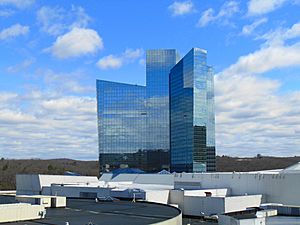Mohegan Indians v. Connecticut facts for kids
Mohegan Indians v. Connecticut (1705–1773) was a very important court case about indigenous land rights in history. It was the first time a case like this was heard under English law. Experts call it the "first major legal test" of how Native American tribes owned land. It was also the "first formal lawsuit" about Native American rights in North America.
This case showed that sometimes, Native American nations on their reserved lands in British colonies followed their own traditional rules, not the rules made for settlers. The Mohegan people weren't saying they owned the land outright. Instead, they argued that certain lands were held in a special arrangement called a trust. This meant the land was managed by the family of John Mason to protect it for the Mohegan tribe.
Much later, in 1979, the Mohegan Indian Tribe started a new lawsuit against the state of Connecticut for some of these lands. A judge decided in 1980 that a law from 1790, called the Non-Intercourse Act, applied to the case. This decision was upheld on appeal. The highest court in the U.S., the Supreme Court, chose not to hear the case.
In 1994, the U.S. government officially recognized the Mohegan Tribe. That same year, a law called the Mohegan Nation (Connecticut) Land Claim Settlement Act was passed. This law allowed the U.S. government to take 800 acres of land and hold it in trust for the tribe. This land became their reservation, and it allowed them to have gambling businesses there.
Contents
The Land Dispute Begins
English colonists arrived in Connecticut in the 1630s. They met the Mohegan people, who had once been part of the Pequot tribe. After the Pequot War in 1637, where the Mohegan helped the colonists fight the Pequot, the Mohegan leader, sachem Uncas, gave most Mohegan lands to the New England Colonies in 1640. He kept a special area for farms and hunting.
In 1659, the Mohegan gave these reserved lands to Major John Mason. He was a future leader in the colony. The land was given to Mason and his family to be their "Protector and Guardian In Trust for the whole Moheagan Tribe." This meant he was supposed to protect the land for the Mohegan.
Mason then transferred the land to the colonial government in 1660. He added a condition: enough land had to be left for the Mohegan to farm. For the next 100 years, both the Mohegan and Mason's family argued that this last transfer was not valid. They said Mason's family still held the land in trust for the Mohegan.
Connecticut became an official colony with a royal charter in 1662. Its borders included the lands that were being argued about. A treaty in 1681 between the Mohegan and the colony recognized that the Mohegan had an interest in the land. It said the colony would give "Equal Justice" to the Mohegan, just like their own people, if the Mohegan followed their laws. However, starting in 1687, the colony began giving parts of the disputed land to settlers through new laws and orders.
The Court Cases
The fight over the land went to court many times over many years.
The 1704 Dudley Commission

In 1704, the Mason family asked the King of England for help on behalf of the Mohegan. They argued that the land given to colonists broke the treaties with the tribe. The King's legal advisor, Sir Edward Northey, said the King could create a special court to hear the case. He also thought Connecticut's actions in giving away the land were "illegal and void." The King agreed and even said he would pay for the Mohegan's legal costs.
In April 1704, the King asked Governor Joseph Dudley of Massachusetts and his council to form a special court. This court was called the “Dudley Commission.” Its decision would be final, but either side could appeal to the King's Privy Council.
The court had several important men, including Governor Dudley. Connecticut argued that this special court didn't have the right to decide the case, so they didn't take part. In 1705, Dudley and the Commission all agreed with the Mohegan tribe.
The 1706 Commission of Review
Connecticut appealed the decision. The King's Privy Council agreed to set up a new group, called a Commission of Review, in 1706. However, this group never actually met.
The 1737 Commission of Review
A second Commission of Review was created in 1737. This group included the Governor of Rhode Island and members from the councils of Rhode Island and New York. This Commission sided with Connecticut in 1738. They said that Ben Uncas, a Mohegan leader who was in a dispute over who should be sachem, was the true leader. They claimed he had recently released Connecticut from the land claim.
After this decision, the New York members of the Commission accused the Rhode Island members of being unfair and left. The final decision was later cancelled because of "alleged irregularities," meaning there were problems with how it was handled. So, a third Commission was called.
The 1743 Commission of Review
The third Commission met in 1743. This time, they sided with Connecticut. The issue of who was the true sachem was not argued again because Connecticut dropped its objection. People who were living on the disputed land were allowed to argue that the original court didn't have the right to hear the case. The Commission eventually decided that the land deeds given to the colonial settlers were valid.
The Privy Council Decision
The Mohegan tribe appealed this decision to the Privy Council, which was the highest court for appeals in the British Empire. The appeal started in 1770. In 1772, the Privy Council sided with Connecticut. They didn't give a written explanation for their decision. The King officially confirmed this decision in 1773.
Significance of the Case
Native American Land Rights
This case is seen as the first time a court ruled on how Native American tribes owned land. In 1823, Chief Justice John Marshall of the U.S. Supreme Court mentioned the Mohegan Indians case in his own famous ruling, Johnson v. M'Intosh. He noted that the Mohegan case was about the details of a land grant and reservations made by the Mohegan, and whether Connecticut had violated those rights.
Experts say this was the "first major challenge" in the 1700s to how colonies controlled their relationships with Native American tribes. It was also called "the greatest cause ever heard at the Council Board."
Tribal Self-Governance
Some people have suggested that the Mohegan Indians case showed that British law recognized Native American tribes as having rights to govern themselves. For example, one historian claimed in 1950 that the Mohegan were "legally regarded as sovereign," meaning they had their own power. However, other experts, like Mark Walters, disagree with this idea. Walters says that if this interpretation were true, it would completely change how we understand the legal status of Native Americans in places like Canada.
Modern Lawsuit and Agreement

In 1979, the Mohegan Indian Tribe filed a new lawsuit against Connecticut. They wanted to get back lands in Montville, Connecticut. In 1980, Judge Blumenfeld ruled that the 1790 Indian Non-intercourse Act applied to these lands. This law said that land deals with Native American tribes had to be approved by the U.S. government.
A higher court, the Second Circuit, agreed with this ruling. The U.S. Supreme Court chose not to hear the case, so the Appeals Court decision stood.
The judge later ruled that the state's ownership of the land was not valid. This was because the land was bought from private parties in a way that broke the Non-intercourse Act. The judge also said that the 18th-century lawsuit did not prevent the Mohegan from bringing this new case. He noted that the 1743 judgment itself recognized the Indians' right to possess the lands.
On March 15, 1994, the U.S. government officially recognized the Mohegan Indian Tribe. On October 19, 1994, the U.S. Congress passed the Mohegan Nation (Connecticut) Land Claim Settlement Act. This law ended all of the Mohegan's original land claims in Connecticut. In return, the U.S. government approved the Mohegan's plan to have gaming operations. The law also allowed 800 acres of land, which were the remaining Mohegan reservation lands, to be held in trust by the United States for the tribe.
The Mohegan Tribe opened the Mohegan Sun casino on October 12, 1996. Since then, they have made it a full resort with a hotel, conference center, restaurants, and shops.

